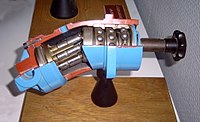
Photo from wikipedia
Abstract In this paper, an experimental test rig has been developed by utilising the free-piston linear generator (FPLG) principle of a dual-piston air-driven system. The mechanical energy of the FPLG… Click to show full abstract
Abstract In this paper, an experimental test rig has been developed by utilising the free-piston linear generator (FPLG) principle of a dual-piston air-driven system. The mechanical energy of the FPLG is converted into electric power through a linear generator. The piston motion, root mean square (RMS) power output, operating frequency, system stability and the conversion efficiency of the FPLG at various inlet pressure and valve opening duration (VOD) are duly discussed in the paper. It is noticed that the piston displacement (stroke) is associated with the VOD and inlet pressure, which have the greatest effect on the FPLG motion characteristics. A long VOD leads to a high piston speed, causing high peak power output. However, the RMS power shows an approximately linear decline with the increase in VOD due to the free-piston dwelling for a certain time at the dead centre position before the exhaust process starts. The FPLG can be achieved a maximum RMS power of 120 W when the inlet pressure is 8 bar and VOD is 30 ms. When the inlet pressure changed from 8 bar to 5 bar, the FPLG operating frequency shows a similar trend and values because it is associated with the piston velocity and stroke. The FPLG Cycle-to-Cycle variation (COV) is low when the inlet pressure is high, and the system stability increases with decreases in VOD. As the VOD increases, the indicated efficiency and work to electrical efficiency increase, whereas the thermal to work efficiency decreases. The maximum indicated efficiency, work to electrical efficiency and thermal to work efficiency achieved are 59.9%, 14.7% and 14.6 %, respectively.
Journal Title: Energy Reports
Year Published: 2021
Link to full text (if available)
Share on Social Media: Sign Up to like & get
recommendations!